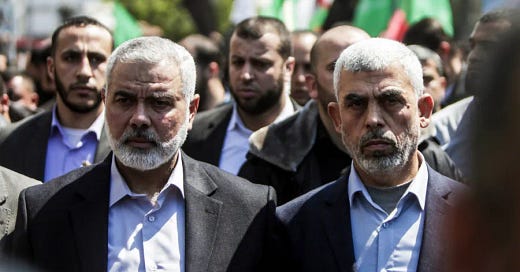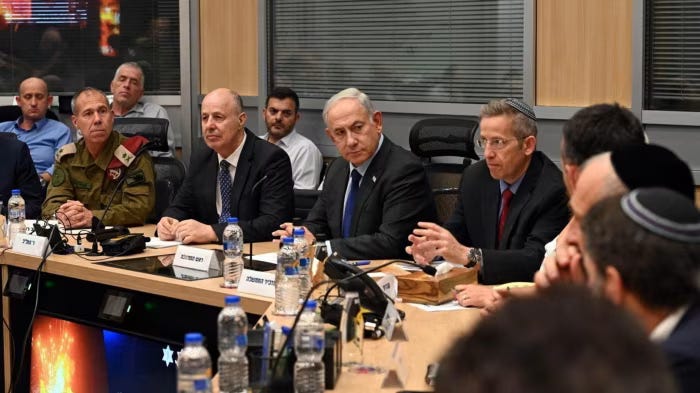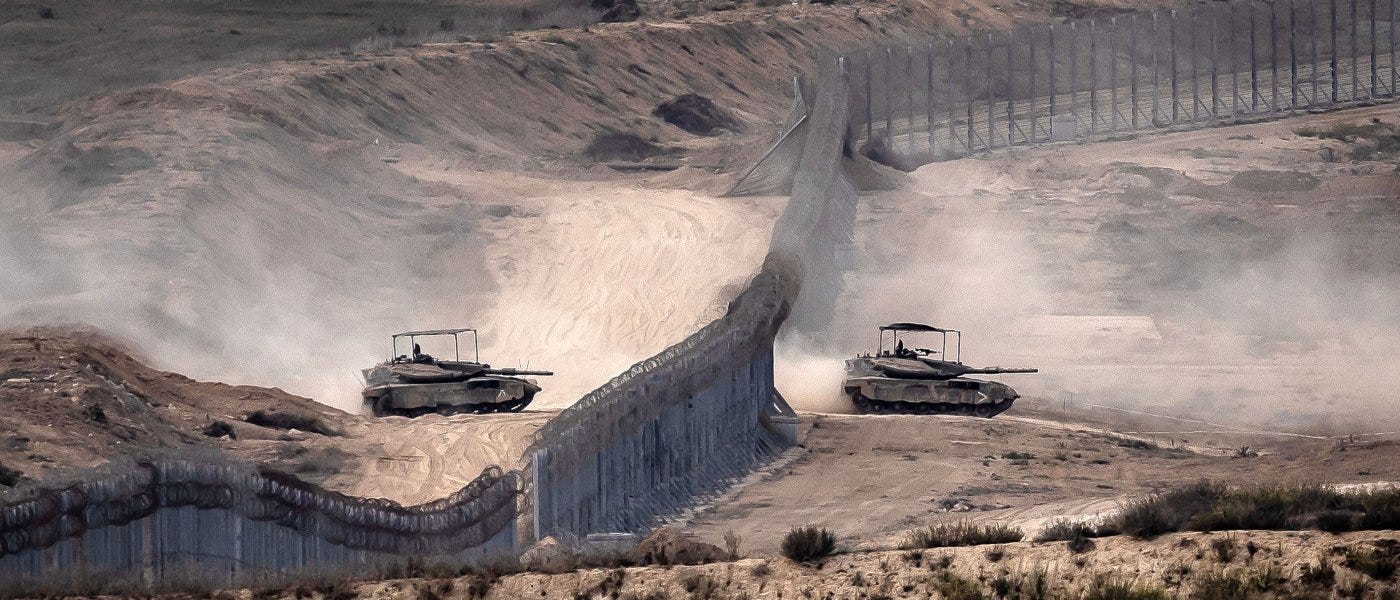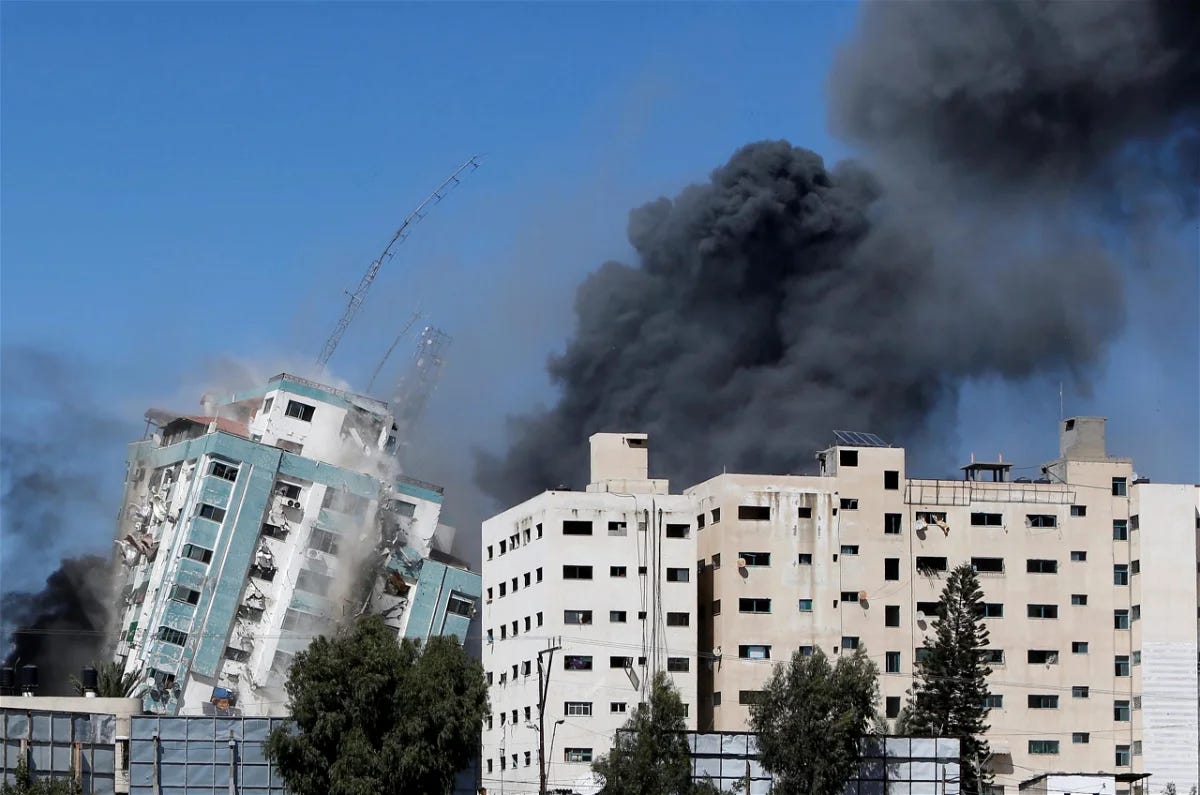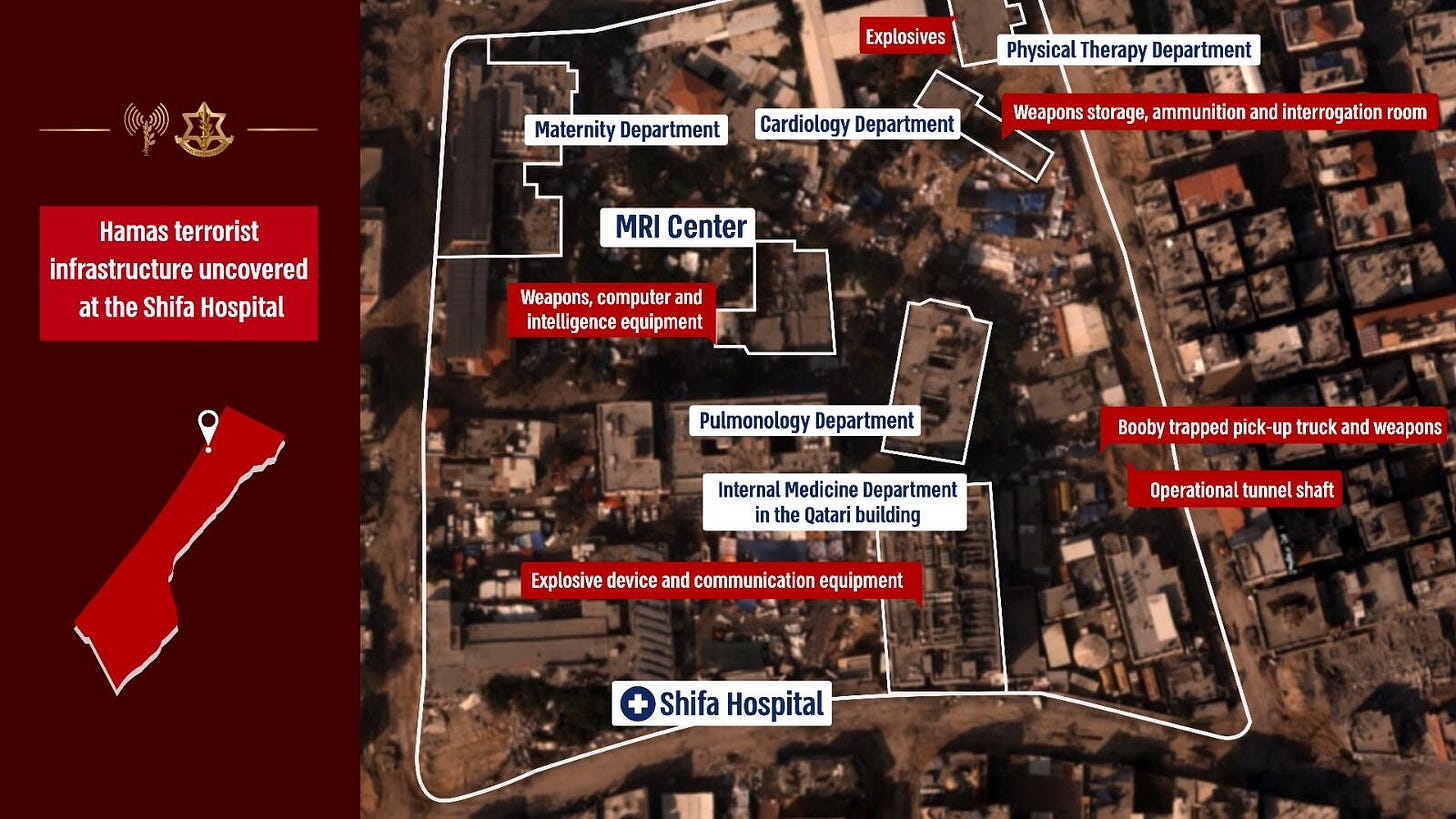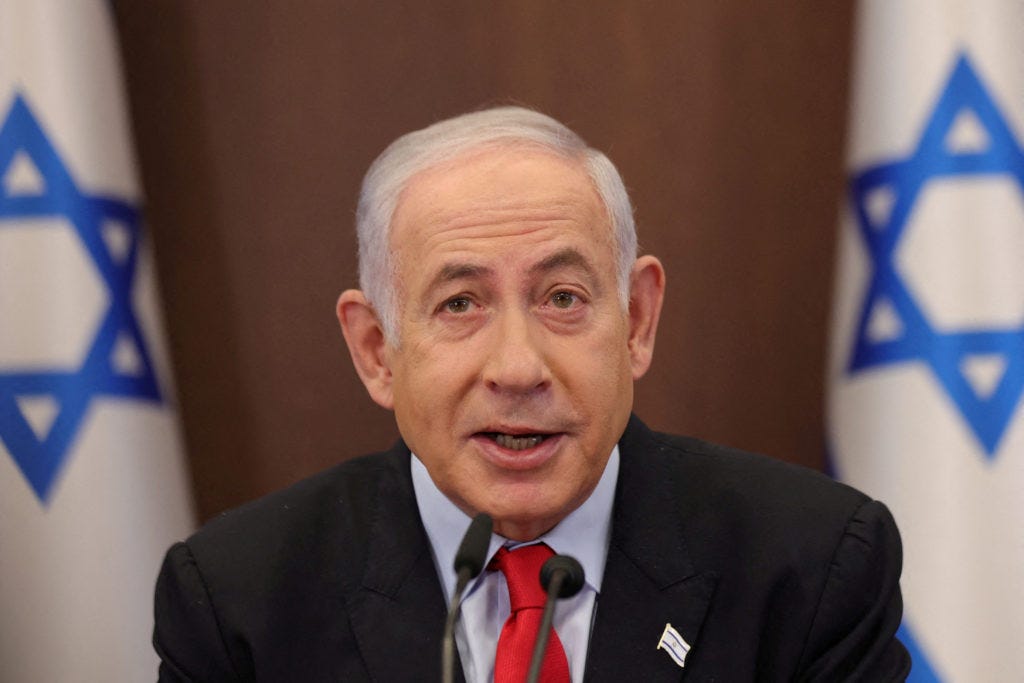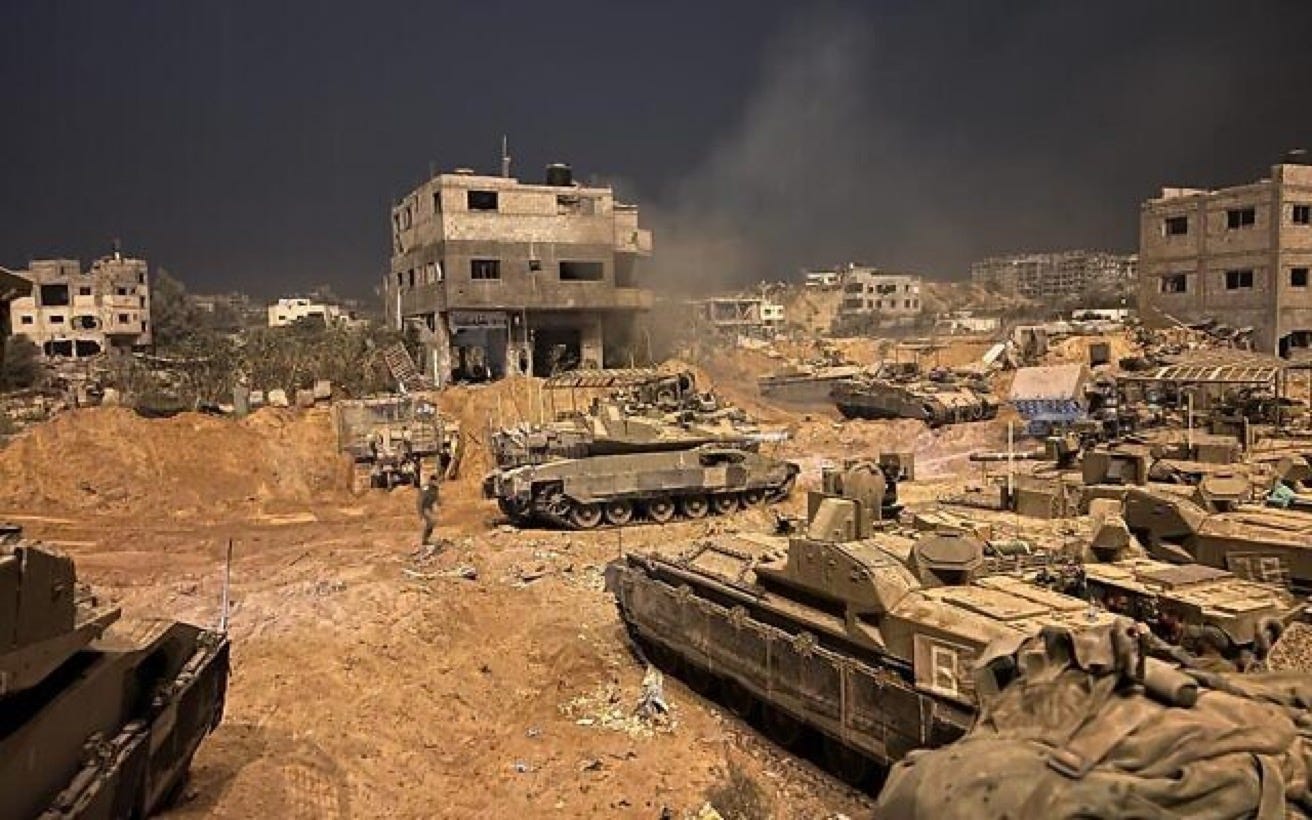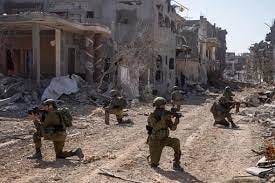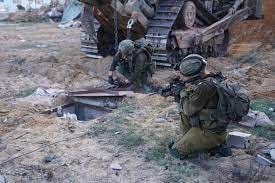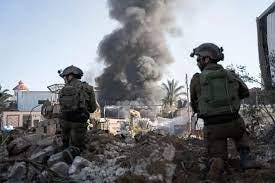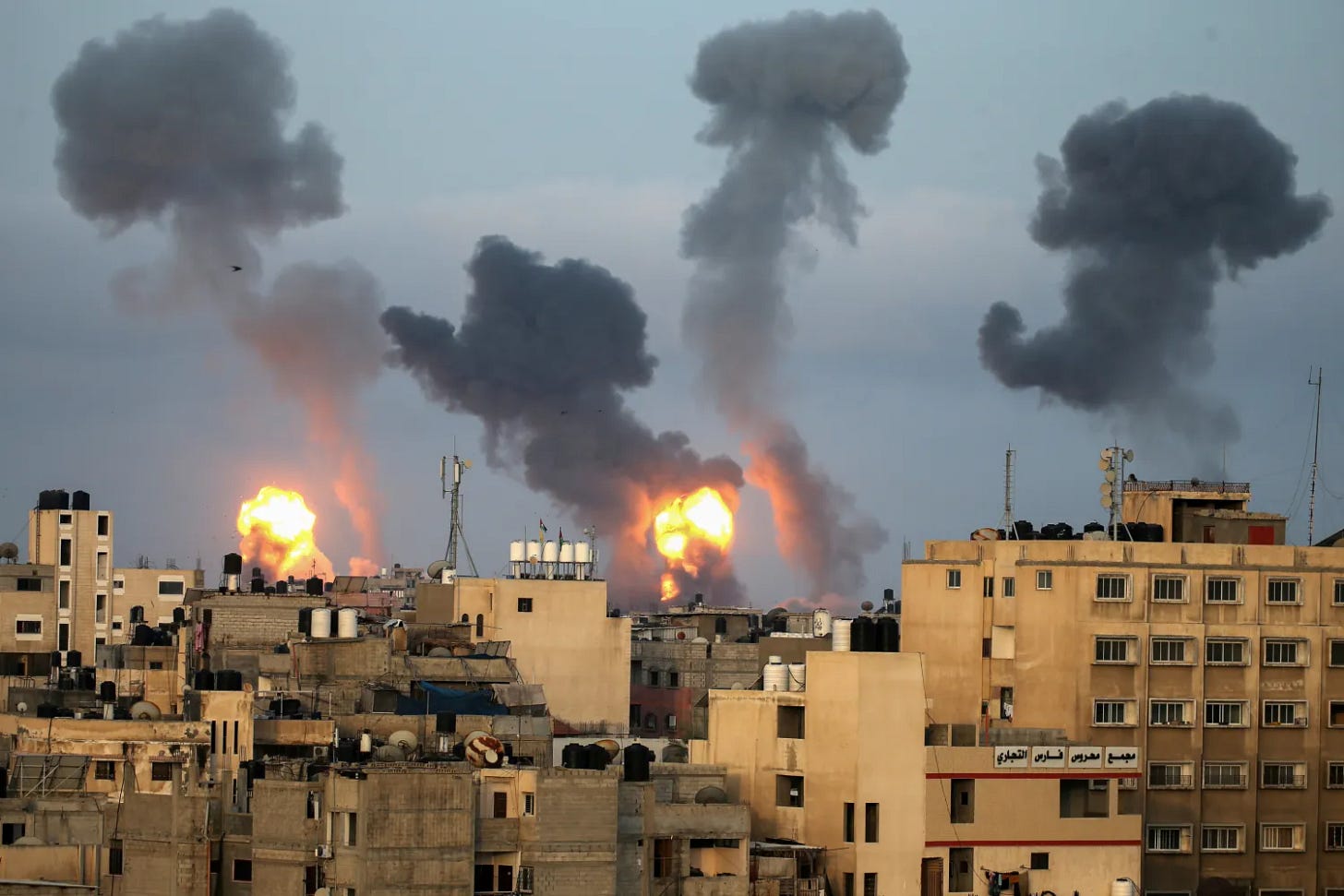Last week I wrapped up the disturbing coverage of the events of October 7, 2023. Today I will begin to go through the Israeli response. If you would like to read the second part of my October 7, post please click the link below.
Israeli Response
After the attack by Hamas the IDF declared a state of emergency for all areas within 50 miles of the Gaza border and that Hamas "made a grave mistake" in launching its attack, pledging that "Israel will win". Residents in areas near Gaza were asked to stay inside, while civilians in southern and central Israel were "required to stay near shelters". Roads around Gaza were closed and the streets of Tel Aviv were also locked down. Israeli Prime Minister Benjamin Netanyahu convened an emergency gathering of security authorities and later that day the Security Cabinet voted to undertake a series of actions to bring about the "destruction of the military and governmental capabilities of Hamas and Palestinian Islamic Jihad". The chief spokesman of the IDF Rear Admiral Daniel Hagari, said 300,000 reservists were being called up for active duty and four divisions were being deployed to the area, augmenting the 31 preexisting battalions.
In a televised broadcast, Netanyahu said:
"We are at war”
He also said that the IDF would reinforce its border deployments to deter others from "making the mistake of joining this war" (the Palestinian Authority in the West Bank and Hezbollah in Lebanon). In a later address, he threatened to "turn Gaza into a deserted island" and urged its residents to "leave now". Israeli President Isaac Herzog said the country was facing "a very difficult moment", and offered strength and encouragement to the IDF, rescue services, and residents who were under attack. Arab-Israeli politicians, including the United Arab List ( a political party in the Knesset), leader Mansour Abbas (no relation to the PA president Mahmoud Abbas) and Arab Knesset member Ayman Odeh, condemned the Hamas-led attack on Israel. Israel's Social Equality Minister Amichai Chikli, said, "the Arab-Israeli population has shown much solidarity and responsibility, and this is especially true for the Bedouin population in the Negev.”
Israeli Police Commissioner Kobi Shabtai announced that a "state of war" existed, following the “massive attack from the Gaza Strip". He also announced the closure of all of southern Israel to "civilian movement" and the deployment of the Yamam counter terrorism unit to the area.
Following the attack, more than 600 militants were captured in Israel. Israel has stated that the interrogation of the suspects revealed significant insights into the group's strategies, and operational methods. Interrogation sessions were held over four weeks in November, mainly in a southern Israeli prison. Interrogation methods used by Shin Bet and Unit 504 included psychological engagement in adherence to Israeli law prohibiting physical coercion. Public release of interrogation videos aimed to validate Israeli military actions and counter Hamas narratives.
The Israel Electric Corporation, which supplies 80% of Gaza's electricity, cut off power to the area. As a result, Gaza's power supply was reduced from 120 MW to 20 MW, forcing it to rely on power plants run by the PA.
Prior to the start of war operations Israel had dropped leaflets calling for the more than one million people living in the north half of the Gaza Strip to evacuate during a 24-hour window, in order to keep them out of harms way. Hamas, on the other hand, told all the residents to stay. In fact, they ordered them at gunpoint not to move. Hamas knew they were going to need their human shields.
From October 7, to October 13.
435 rockets were fired into Israel between October 8 and October 13 by both Hamas and Hezbollah. On October 13, the IDF sent armored vehicles and infantry into the Gaza Strip, stating that their goals were to attack Hamas militants and rescue hostages. The operation, according to Israeli officials, was not part of a widely anticipated ground invasion, but rather a raid in which troops would only temporarily enter the Gaza Strip. The IDF confirmed the same day that Israeli remains were located and retrieved in the Gaza Strip.
The week of October 13 to October 20.
547 rockets were fired into Israel this week. No militarily significant events happen this week.
The week of October 20, to October 27.
437 rockets were fired into Israel this week. On October 21, 2023, the IAF Dropped more leaflets in Gaza with the message: "Urgent warning! To the residents of Gaza: your presence to the north of Wadi Gaza is putting your lives at risk. Anyone who chooses not to evacuate from the north of the Gaza Strip to the South of the Gaza Strip may be identified as a partner in a terrorist organization."
On October 25, Israel conducted another raid, lead by the Givati Brigade and the 162nd Armored Division. This was the largest incursion so far, with both infantry and tanks involved. The next night they conducted a second raid into Gaza, this time aimed at the Shuja’iyya neighborhood of Gaza City.
On the evening of October 27, the IDF launched a large-scale assault on the towns of Beit Hanoun and Burejj accompanied by large-scale airstrikes that cut off cell phone service and internet access in Gaza. Flotilla 13 also carried out a strike on Hamas naval forces along the Gazan coast. Israel announced that the units inside Gaza from the raid on the 25th, did not withdraw, marking the beginning of the invasion of Gaza.
Prime Minister Netanyahu announced that the “second phase of the war had begun” and the IDF reissued its call for Gaza residents to evacuate the north. As Operation Swords of Iron started the IDF advanced on three fronts: from the northeast near Beit Hanoun, from the northwest near Beit Lahia, and from the east near Juhor ad-Dik. Awaiting them were fighters of Hamas and Palestinians Islamic Jihads. Hamas, the bigger and more dangerous foe, had stockpiled ample supplies to help sustain its fight against Israel, including hundreds of thousands of gallons of fuel for vehicles and rockets; caches of ammunition, explosives and materials to make more, and stockpiles of food, water and medicine. They had gathered these supplies to the detriment of the civilian population of Gaza, who struggled to obtain basic necessities.
IDF spokesman Rear Admiral Daniel Hagari said, “the Air Force is heavily striking underground targets. In addition to the attacks that we carried out in recent days, ground forces are expanding their activity this evening. The IDF is acting with great force to achieve the objectives of the war.”
This did not go over well in the rest of the world. In the US, Biden made statements acknowledging that Israel had a right to defend itself, but at the same time, Secretary of State Antony Blinken was pressuring Israel to accept a cease-fire as soon as possible, regardless if the consequences for Israel. Also, unnamed White House officials, made statements, that efforts to evacuate foreign nationals through the Rafah border crossing were being temporarily hindered by the refusal of Hamas to allow anyone to leave, until a number of its own wounded were evacuated. Implying that an Israeli agreement on a cease-fire would help the situation.
Turkey was also very unhappy with the Israeli operation and recalled its ambassador to Israel, stating: "in view of the unfolding humanitarian tragedy in Gaza caused by the continuing attacks by Israel against civilians, and Israel's refusal to accept a cease-fire." President Recep Tayyip Erdogan told reporters he held Netanyahu personally responsible for civilian deaths in Gaza and said that he was "no longer someone we can talk to".
The week of October 27, to November 3.
At least 1,000 rockets were fired into Israel this week. On October 28, IDF Chief of Staff Lieutenant General Herzi Halevi said in a recorded video that “this war has stages, and today we moved into a new phase. Our forces are currently carrying out ground operations in the Gaza Strip, which serve to achieve all the war’s objectives: dismantling Hamas, security at the borders, and supreme efforts to return the hostages back home. The objectives of the war require ground entry, in order to expose the enemy and destroy it, there is no other way but to enter its territory with great force.
The IAF said that airstrikes had killed Issam Abu Rukbeh, head of Hamas’s aerial forces, who orchestrated the October 7, paraglider infiltration, and drone attacks targeting the IDF. Overnight on October 28, the IDF launched an airstrike that killed the commander of the Gaza City Brigade naval forces, Rateb Abu Sahiban, who had commanded a failed Hamas infiltration attempt on October 24.
On October 29, the IDF revealed through the recorded calls of terrorists, infographics, and 3D illustrations that Hamas was, and had been, using a labyrinth of tunnels underneath Shifa Hospital, the largest hospital in Gaza, as an underground headquarters and arms depot for years, including during Operation Protective Edge in 2014.
Israeli fighter jets struck rocket launchers in Syria that had launched rockets against the Golan Heights hours earlier. Israel reopened the second of three water pipelines into Gaza, allowing 7.5 million gallons of water to flow per day. Israel had shut off the pipelines, which account for 9% of Gaza’s water supply, on October 9.
On October 30, the IDF began a “major advance” into Gaza City involving infantry, tanks, artillery, and combat engineers. The IDF also announced that it killed five senior terrorist operatives in the previous 24 hours, including: Tisir al-Jouti, a senior member of Palestinian Islamic Jihad, Jamil Baba, a commander of Hamas’ naval forces, Muhammad Safadi and Muwaman Heagazi, commanders in the Tafah brigade and Muhammad Awadallah, a senior member of Hamas’s munition production unit.
The IDF dropped numerous leaflets in the Gaza Strip warning terrorists to surrender. The leaflets said, “disarm, raise your hands, if possible – wave a white flag. Act in accordance with the IDF’s instructions and there will be no need to bring food and water with you – we will take care of that.”
Prime Minister Netanyahu held his first press conference since the war began, alongside Israeli Defense Minister Yoav Gallant. Netanyahu announced that:
“this is the second stage of the war whose goals are clear; to destroy Hamas’ governing and military capabilities, and to bring the hostages home.”
He added that “broadening the ground offensive does not clash in any way with our ability to return the hostages.” Netanyahu also claimed that the war will be “long and hard, and we are ready. It is our second War of Independence, we will fight to defend the homeland. We will fight, and we will not withdraw.” Gallant said that rescuing the hostages “is not a secondary mission” and reiterated that “over the last day, we advanced to a new stage. There is no diplomatic time limit, only an operational clock.”
The IDF and the Shin Bet announced that Israeli special operators rescued soldier Uri Magidish after Hamas had abducted her during the October 7, attack. Israeli Defense Minister Yoav Gallant said, “this rescue operation is further proof of our ability to reach the hostages, the importance of the ground operation, and above all our commitment to each and every one of the hostages.”
On October 31, the IDF struck numerous anti-tank missile launching points, rocket launching positions, underground tunnels, and military compounds from the air and also engaged terrorists above and below ground, while conducting operations in Gaza. The IDF was advancing into Gaza in three different locations, including large infantry advances in central Gaza just south of Gaza City, an armored advance into northeast Gaza near the Erez Crossing, and another infantry assault entering northwest Gaza along the Mediterranean Sea.
The IDF announced that they had killed Nasim Abu Ajina, commander of the Beit Lahia Battalion of Hamas Northern Brigade. Abu Ajina was the Hamas commander who directed the October 7, attack against the Israeli kibbutz of Erez and the Israeli town of Netiv HaAsara, and he also commanded Hamas’s Aerial Array unit that helped develop drones and motorized paragliders used in those attacks.
The IAF carried out an airstrike in the Jabaliya refugee camp, that targeted and killed, Ibrahim Biari, the commander of the Central Jabaliya Battalion. The airstrike also collapsed Hamas terror tunnels at the camp as well as nearby buildings. Meanwhile, Houthis in Yemen launched missiles at Israeli vessels in the Red Sea, none of the missiles hit their targets.
On November 1, the IAF struck several targets in Gaza, including Hamas command centers, facilities belonging to PIJ, and a building in Jabaliya known as a Hamas meeting point. They also killed fifty terrorists and destroyed weapons caches and entrances to the terror tunnel network.
The IDF shelled positions on the Lebanese border that had launched missiles against Israeli troops and Tel Hai College. Later in the day, 46 wanted Palestinians were arrested in the West Bank, including thirty with ties to Hamas.
In response to the missiles fired by the Houthis in Yemen the day before, the Israeli Navy deployed Saar-class missile boats in the Red Sea.
The commander of the IDF’s 162nd Division Brigadier General Itzik Cohen said Israeli troops are “at the gates of Gaza City” and told reporters that “Hamas chose this war, we did not choose this war.” He added that his goal is “to go and decisively finish Hamas” and added “we have destroyed much of Hamas’s abilities, attacked its strategic facilities, all of its array of explosives, its underground tunnels and other facilities.” He pledged that Israel will win this “long task.” IDF Spokesman Rear Admiral Daniel Hagari said the IDF ground forces broke through Hamas’s defensive lines in northern Gaza and that “the ground operation is progressing as planned.” He added that the IDF accomplished this “with advance planning, precise intelligence, and joint attacks from the land, air, and sea.”
The IDF exposed a network of “catfishing” social media profiles whose operators sought to build relationships with Israeli soldiers in order to extract information from them for Hamas.
The week of November 3, to November 10.
500 rockets were fired into Israel from both Gaza and Lebanon. IDF forces began encircling Gaza City, according to a November 2, statement from IDF Chief of Staff Herzi Halevi, IDF troops are in the “heart of a ground operation in the northern Gaza Strip.” He added, “our forces are fighting in a built-up arena, which are crowded, complex and requires professional fighting and a lot of bravery.” 100 Hamas tunnels have already been destroyed in Gaza with IDF Engineers using a variety of assets, including robots, to destroy the tunnels and detonate booby traps set near tunnel entrances.
The IDF announced that it had killed Mustafa Dalul, a battalion commander in the Gaza City Brigade. The 13th Battalion of the Golani Brigade and the 53rd Armored Battalion fought several terrorist cells in Gaza, using aircraft and artillery strikes to neutralize the terrorists resulting in heavy Hamas casualties. The IAF struck targets in Lebanon after an earlier rocket attacks, striking Hezbollah infrastructure targets, command and control centers, rocket launching positions and weapons depots.
IDF spokesperson Daniel Hagari announced on November 5, that the IDF had fully encircled Gaza City and split Gaza into two, and he added that the IDF’s Golani Brigade reconnaissance unit had reached the Gaza coastline. Hagari stated, “today there is north Gaza and south Gaza.”
On November 6, the IDF continued to expand its operations in Gaza, and announced that it had struck numerous Hamas military compounds, observation posts, and anti-tank missile launching positions. They also captured a Hamas military compound, including ammo storage and training facilities, as well as tunnels. The IDF also announced that it killed two major Hamas commanders. Jamal Mussa, head of special security operations for Hamas, and Wael Asfeh, commander of the Deir al Balah battalion.
The IDF announced that it had reopened an evacuation route for civilians to move south of Wadi Gaza. The IAF launched strikes on targets in Lebanon in retaliation for Hezbollah missile attacks against Israel. The IDF also announced that the Israeli army had arrested 36 wanted Palestinians in raids across the West Bank, including eighteen suspected members of Hamas, and had killed an Islamic State operative during the raids.
In an interview with ABC News, Prime Minister Benjamin Netanyahu said that Israel would not accept a ceasefire until all hostages are released and that Israel would have to maintain overall responsibility for security in Gaza for an indefinite amount of time. Regarding the prospects of a ceasefire, Netanyahu said:
“There’ll be no ceasefire, or general ceasefire, in Gaza without the release of our hostages.”
“As far as tactical little pauses, an hour here, an hour there. We’ve had them before, I suppose, we’ll check the circumstances in order to enable goods, humanitarian goods to come in, or our hostages, individual hostages to leave. But I don’t think there’s going to be a general ceasefire. I think it will hamper the war effort. It’ll hamper our effort to get our hostages out because the only thing that works on these criminals in Hamas is the military pressure that we’re exerting.” Netanyahu said that if hostages were released, “there will be a ceasefire for that purpose.” He added, “I think Israel will, for an indefinite period, have the overall security responsibility because we’ve seen what happens when we don’t have it. When we don’t have that security responsibility, what we have, is the eruption of Hamas terror on a scale that we couldn’t imagine.”
IDF Spokesman Rear Admiral Daniel Hagari said that the IDF is “deepening the pressure on Gaza City,” and the IDF killed several Hamas field commanders overnight. He also noted that the IDF is destroying every Hamas tunnel that they find. The IAF struck Hezbollah “technological assets,” a weapons storage facility, rockets, and additional targets and IDF artillery shelled the source of a barrage of thirty rockets from Lebanon that had been launched that morning.
At 11:00 am on November 7, Israel observed one minute of silence during a national day of mourning one month after the October 7.
IDF forces targeted command-and-control nodes and hideouts on the outskirts of Gaza City and struck key targets in the city. IDF spokesman Rear Admiral Daniel Hagari stated that the IDF is operating “on the ground deep inside Gaza City” and that Israel has destroyed over 100 Hamas tunnel shafts since its operations in Gaza began. Hagari added that the IDF has struck over 14,000 targets in the Gaza Strip and captured valuable intelligence materials and over 4,000 weapons, including rocket launchers, anti-tank missiles, rocket-propelled grenades, dozens of machine guns, surface-to-air missiles, and other munitions. They also found a rocket launching sites near a mosque in Gaza City.
On November 8, the IDF said that it killed Mohsen Abu Zina, head of weapons production facilities for Hamas. The IDF announced on X that it was putting in place a four-hour window for civilians to evacuate from northern Gaza. The announcement stated that Israel had established a “safe corridor” down Salah-al-din Road to an area south of Wadi Gaza. The window was later extended by an hour with the IDF urging Gazans:
“for your safety, join the many thousands who headed to the southern Wadi Gaza area since the morning hours. Seize the opportunity until three o’clock in the afternoon to protect yourselves and members of your families.”
The Prime Minister’s office announced that Mossad was involved in thwarting a plot orchestrated by Hezbollah and Iran to attack Jewish targets in Brazil. Brazilian police announced that they had arrested two people in the city of Sao Paulo in connection with the attack but declined to speak about connections to Hezbollah or Iran. The Mossad released a statement on November 8, stating that “Brazilian security services, together with the Mossad and its partners in the Israeli security community, alongside additional international security and enforcement agencies, have foiled a terrorist attack in Brazil, which had been planned by the Hezbollah terrorist organization, directed and financed by the Iranian regime. The Mossad thanks the Brazilian security services for the arrest of a terrorist cell that was operated by Hezbollah in order to carry out an attack on Israeli and Jewish targets in Brazil.”
On November 9, the IAF DF announced that fighter aircraft had struck Hezbollah anti-tank missile launching sites, military structures, operational posts, and technological assets, in Lebanon in response to earlier launches. The IDF also announced that it had attacked a Hezbollah cell in Lebanon near the area of Biranit along the Lebanese-Israeli border.
The IDF announced that an airstrike had killed Ibrahim Abu-Maghsib, head of the Central Camps Brigade Anti-Tank Missile Unit. IDF troops also captured a key stronghold, called Outpost 17, in west Jabaliya after a ten-hour battle, both above and below ground with Hamas and Palestinian Islamic Jihad fighters.
IDF spokesperson Rear Admiral Daniel Hagari said that approximately 50,000 civilians had left northern Gazan and traveled to southern Gaza using the humanitarian corridor of Salah al-Din Road Israel had opened up for several hours the day before. Israeli Defense Minister Yoav Gallant told the directors general of government ministries, local officials, and the head of the IDF Home Front Command that Israel is “in a prolonged war, and the issue of the civilian economy is a main factor in the management of the war. We need to resolve things quickly, even if not perfectly.” He added that the IDF ground operation “suppresses a significant part of the threat to the home front. The rocket fire by Hamas these days is mainly intended to disturb the routine of life. We need to make sure that the citizens are given security and the ability to have an uninterrupted daily routine.”
Admiral Hagari also reported that the entire 252nd Division is operating in Gaza, marking the first time since the 1982 Lebanon War that an entire IDF reserve division was operating in enemy territory and that Israeli forces had captured the Beit Hanoun area in northern Gaza destroying multiple compounds, rocket launch positions and tunnels as well as killing hundreds of Hamas operatives. In the Sheikh Radwan neighborhood of Gaza City, IDF troops found a Hamas drone manufacturing operations next door to a school, in a residential building, in the room next to a child’s bedroom. This shows that Hamas will stoop to the lowest levels in their quest to turn everyone in Gaza into a Hamas martyr, whether or not they even have the capacity to understand what that means.
Every day since this conflict began, the Gaza Health Ministry puts out figures for the number of Palestinians that have been killed and wounded in Israeli operations. Of course, this organization is run and funded by Hamas, so the figures it releases have to be taken with a grain of salt the size of the Empire State Building. Even President Biden doesn’t trust their numbers, having said: “I have no notion that the Palestinians are telling the truth about how many people are killed. I have no confidence in the number that the Palestinians are using.” For example on November 9, the Gaza Health Ministry stated that 10,328 people have been killed in Gaza and nearly 26,000 have been injured during the war so far. Since Israel is doing everything in their power to limit civilian deaths I find it hard to believe that they are killing 333 people a day. They also do not distinguish between terrorists and real civilians which also affects the numbers. You also have to look at the number of Gazans that support Hamas, even after the October 7, attacks. A survey was conducted from November 22, to December 2, with a margin of error of 4%. Poll workers conducted 481 in-person interviews in the Gaza Strip during the weeklong cease-fire that ended December 1. The poll indicated that 57% of respondents believe Hamas was correct in launching the October attack. A large majority believed the claim that Hamas acted to defend the al-Aqsa Mosque against Jewish extremists and win the release of Palestinian prisoners. Only 10% said they believed Hamas had committed war crimes, with a large majority saying they did not see videos showing the militants committing atrocities. After seeing these numbers and thinking about the evidence that “civilian Palestinians are involved in the holding of hostages as well as the sacking of Israeli communities during October 7, it is hard for me to feel sorry for Palestinians that have been killed in the war. It is even hard to feel bad for the children, and that is usually my red line (don’t intentionally hurt kids), but watch these two videos and tell me that those children have been raised to respect their Israeli neighbors? The first clip is a news story from Al Jazeera TV, certainly no friend of Israel, and even they think it is a bad idea to do this to kids. The second clip is a longer version of the part about the killing of the Mickey Mouse-like character.
If you are still not convinced watch this video. It is a Hamas “summer camp”
I don’t know how long it will take, or if it is even possible, to deprogram these children but unless something is done this cycle of violence will continue.
Next week I will finish up my examination of Operation Swords of Iron and the week after I look at who and what make Hamas be able to operate. I will not cover the entire operation for two reasons; one, it is an ongoing operation and I would just end up doing this forever; and two, it would take three more parts just to get to today, and I don’t really want to do that. I hope you are learning things to counteract the idiots out there who believe that Israel is committing genocide against the Palestinians. These people who are chanting “from the river to the seas, Palestine must be free”. I’ll bet you a lot of money that they don’t even know from what river to which sea. They’re just a bunch of virtue-signalling morons.
Chris

